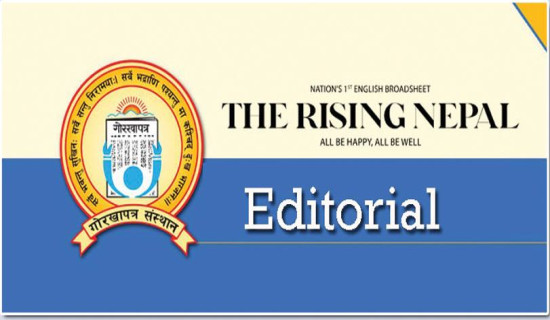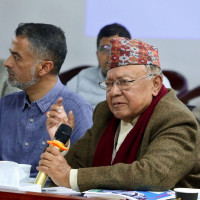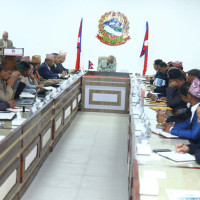- Tuesday, 23 December 2025
Enhance Dalit Women's Roles In Public Life
Dalit women continue to experience systematic exclusion from decision-making roles at all levels of government, despite the constitutional guarantee of inclusion. Although the constitution guarantees their economic, social and political empowerment through proportional representation in the executive, legislature and judiciary, their participation is significantly low. They face the double burden of caste-and gender-based discrimination while their longstanding struggle for justice and representation continues. It was only in 2063 BS that, for the first time, six Dalit women were elected to the Interim Legislative Parliament.
In 2064 BS, 25 Dalit women were elected to the Constituent Assembly, but the number significantly reduced to 22 in 2070 BS. In the 2074 BS parliamentary elections, only 14 Dalit women reached the House of Representatives (HoR). Currently, only eight Dalit women are represented in the HoR. On the other hand, their presence in the National Assembly is almost zero. In all seven provincial assemblies, 24 Dalit women were elected in 2074 BS.
Underrepresentation
The number increased to 27 in 2079 BS. So far, no Dalit women have served as a cabinet minister in the federal government. Kalawati Paswan was the first Dalit woman to become the Assistant Minister for Physical Infrastructure and Construction in 2066 BS. The few Dalit women who have served as Ministers of State in 2068 BS include Rajani Ram, Dhanmaya BK, Bimala BK, Asha BK, Sushila Shreepali Thakuri and Rupa BK.
At the provincial level, Sita Nepali became the first woman Minister for Internal Affairs and Law in 2078 BS, followed by Sita Kumari Sundas, who served as the Minister for Economic Affairs in 2079 BS. So far, four Dalit women have served as provincial ministers of state. In local governments, the trend is also discouraging. In 2074 BS, 21 women were elected deputy mayors or vice-chairpersons. But in 2079 BS, the number decreased to 12.
In the same year, five Dalit women were elected deputy chiefs in the District Coordination Committee and 89 served as members. Similarly, 6,630 Dalit women were elected as ward members, while 13 Dalit women became mayors of municipalities and 12 served as chairs of rural municipalities. Altogether, 229 served as deputy mayors while 335 became vice-chairpersons. Similarly, 69 women were elected ward chairpersons and 6,594 Dalit women ward members.
In political parties, Dalit women remain underrepresented. Only four are members of the Nepali Congress, five of the CPN-UML, 18 of the CPN (Maoist Center), two of the Rastriya Swatantra Party, one of the Rastriya Prajatantra Party, and six of the CPN (Unified Socialist). Durga Sob is the only person to serve as a central office bearer in the Nepal Samajwadi Party. Despite the constitutional and legal provisions for proportional representation, many Dalit women are denied access to leadership positions, with quotas often filled by more privileged individuals. As a result, their representation in parliament and key decision-making roles remains discouraging.
According to a study conducted by WOREC, Nepal, a movement-based organisation advocating for the rights of women, Dalit women account for seven percent of rape cases, highlighting their vulnerability to violence. The World Bank notes that Dalit women are doubly marginalised due to the caste system and gender inequality. They are forced to suffer violence both at home and in public, often under the guise of accusations like witchcraft. In civil service, the Dalit community's representation is only 2.8 percent, with very few Dalit women.
It took 66 years following the enforcement of the Civil Service Act for a Dalit woman, Sita Pariyar, to become the Chief District Officer of Humla. According to the 2078 BS census, the Dalit community constitutes 13.4 percent of the total population of the country. But, Dalit women's representation across federal, provincial and local bodies, including executive, legislature, and judiciary, constitutional bodies, and public corporations, remains extremely low. Their representation in the legal and justice sector is also minimal.
Proportional representation
Lax implementation of constitutional provisions, including the Preamble, Articles 24 and 40, which guarantee protection against untouchability and ensure inclusion, is blamed for this gap. The state must make and enforce policies ensuring women's proportional representation in leadership roles across all levels of government, including executive, legislature and judiciary, and at the policy-making level.
The legal mandate of 33 percent women's representation in state bodies should be properly enforced. A Dalit-responsive budgeting system must be implemented at all federal, provincial and local levels. It is necessary to conduct leadership trainings, capacity-building events and awareness programmes to empower Dalit women and enhance their roles in public life.
(Darnal is a journalist at the National News Agency (RSS))

















